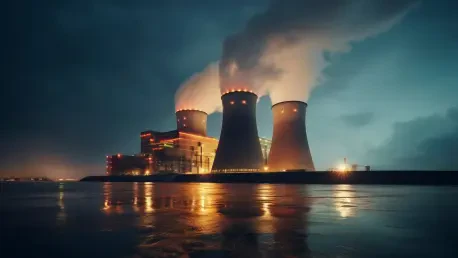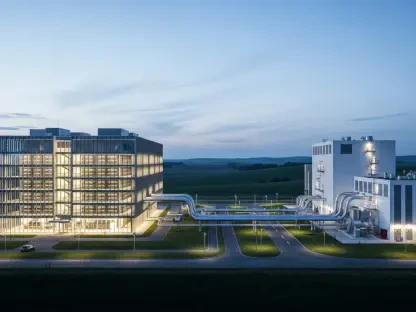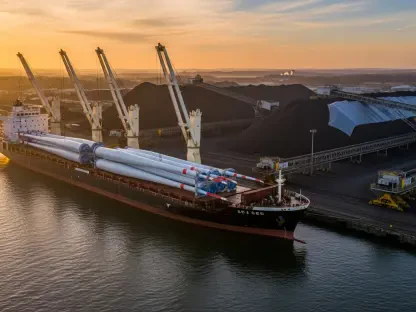Imagine a future where clean, reliable energy powers the nation without the carbon footprint of fossil fuels, and nuclear technology leads the charge with unprecedented speed. The U.S. Department of Energy (DOE) has set this vision in motion by selecting 11 advanced reactor projects from 10 innovative companies for a groundbreaking pilot program. Aimed at achieving criticality by mid-2026, this initiative bypasses traditional regulatory hurdles to accelerate nuclear innovation. This roundup gathers diverse opinions, expert insights, and critical viewpoints from industry leaders, safety advocates, and policy analysts to explore the implications, challenges, and potential of this ambitious endeavor. The goal is to provide a balanced perspective on how this program could reshape energy production while addressing concerns that accompany such rapid progress.
Exploring the Push for Rapid Nuclear Innovation
Unpacking the DOE’s Bold Strategy
The DOE’s pilot program represents a seismic shift in how nuclear technology is developed, leveraging authority under the Atomic Energy Act to sidestep initial Nuclear Regulatory Commission (NRC) licensing. Industry voices have hailed this as a long-overdue move to cut through red tape that has stalled nuclear advancements for decades. Many company representatives involved in the program emphasize that streamlined processes could position the U.S. as a global leader in advanced reactor technology by allowing test reactors to be built and operated swiftly.
However, not all feedback is glowing. Some policy analysts caution that while speed is essential for innovation, the lack of early NRC oversight might create blind spots in regulatory frameworks. They argue that historical delays in nuclear projects often stemmed from necessary safety checks, and bypassing these could set a risky precedent. This tension between urgency and caution forms a core debate surrounding the initiative.
A third perspective comes from economic observers who note that the program’s structure, with companies bearing all costs from design to decommissioning, might accelerate private investment. They suggest that this cost-sharing model could invigorate the sector by aligning government support with market-driven solutions, though concerns linger about financial burdens on smaller firms unable to sustain such expenses over extended timelines.
Industry Leaders Weigh In on Collaboration
Collaboration stands out as a cornerstone of this initiative, with 10 companies, including notable players like Oklo with multiple projects, driving diverse technological approaches. Industry insiders praise the DOE for fostering a competitive yet cooperative environment where firms can share insights while pushing unique reactor designs. This collective effort is seen as a catalyst for breakthroughs that might not emerge in isolated development.
Contrasting views arise from smaller companies within the cohort, who express mixed feelings about the competitive landscape. While they appreciate the DOE’s backing, some highlight the challenge of matching resources with larger counterparts, suggesting that unequal financial capacity could skew innovation toward well-funded entities. This disparity raises questions about whether the program truly levels the playing field.
Analysts tracking nuclear sector trends point out that the collaborative model could set a new standard for public-private partnerships in energy development. They argue that if successful, this approach might inspire similar initiatives in other clean energy fields, though they stress the importance of transparent mechanisms to ensure smaller players aren’t overshadowed by industry giants.
Safety vs. Speed: A Critical Debate
Concerns Over Regulatory Oversight
Safety remains a hot-button issue in discussions about the DOE’s fast-track program. Advocates for stringent regulation express alarm over the decision to bypass initial NRC licensing, warning that insufficient early oversight could lead to undetected flaws in reactor designs. They cite past nuclear incidents as evidence that rigorous checks are non-negotiable, regardless of innovation goals.
On the other side, proponents of the program argue that modern engineering and advanced safety features in new reactor designs mitigate many traditional risks. They contend that the DOE’s direct control and eventual NRC involvement for commercial licensing provide adequate safeguards, dismissing claims of recklessness as outdated fears not reflective of current technology.
A middle-ground perspective emerges from independent safety consultants who suggest that while innovation is vital, the DOE must establish clear interim accountability measures. They recommend real-time monitoring and public reporting during the testing phase to build trust and ensure that communities near test sites are not exposed to unforeseen hazards, balancing progress with precaution.
Public Perception and Trust-Building
Public trust is another focal point, with community advocates voicing unease about reduced regulatory scrutiny. Many stress that without clear communication from the DOE about safety protocols, local populations might resist projects in their regions, potentially stalling even the most promising designs. They urge greater transparency to alleviate fears of radiological risks.
Industry responses counter that public skepticism often stems from misinformation about nuclear energy’s safety record. They point to extensive outreach plans and educational campaigns as tools to reshape perceptions, arguing that showcasing the low-carbon benefits of advanced reactors could win over doubters if paired with visible safety commitments.
Policy experts add that historical nuclear programs offer lessons on trust-building, noting that past failures to engage communities led to backlash. They advise the DOE to prioritize stakeholder dialogue and independent audits during the pilot, suggesting that proactive engagement could turn public opinion into a supportive force rather than an obstacle.
Technological Horizons and Global Implications
Next-Gen Reactor Designs in Focus
The technological diversity of the selected projects garners significant attention, with experts in nuclear engineering applauding the range of concepts being tested. From microreactors to molten salt designs, the program is viewed as a proving ground for solutions that could redefine energy grids. This experimentation is seen as a bold step toward sustainable power generation.
Global energy analysts highlight that U.S. advancements in this arena could influence international markets, especially in regions seeking reliable clean energy alternatives. They note that if successful, these designs might be exported or adapted abroad, strengthening American leadership in nuclear tech, though they warn of geopolitical challenges in maintaining a competitive edge.
A more cautious take comes from technology historians who remind us that innovation cycles in nuclear energy often face unexpected hurdles. They suggest tempering enthusiasm with realistic timelines, pointing out that even cutting-edge designs require extensive validation to ensure scalability and safety, urging patience alongside ambition.
Regional Interests and Economic Impact
Regional stakeholders, particularly from areas hosting test reactors, offer insights into localized benefits and concerns. Economic development leaders in these zones anticipate job creation and infrastructure growth, viewing the pilot as a boon for struggling communities. Their optimism centers on nuclear energy as a driver of long-term prosperity.
Conversely, environmental groups in the same regions raise flags about potential ecological disruptions during construction and operation. They call for stringent impact assessments to protect local ecosystems, arguing that economic gains should not come at the expense of natural resources or community well-being.
Economic forecasters provide a broader lens, suggesting that the program’s outcomes could ripple through national energy policies. They predict that successful pilots might spur investment in nuclear infrastructure over the next decade, though they caution that regional disparities in benefits could exacerbate existing inequalities if not addressed through targeted policy.
Reflecting on the Roundup and Next Steps
Looking back, this exploration of the DOE’s nuclear pilot program revealed a complex tapestry of optimism, caution, and critical discourse. Industry leaders celebrated the push for rapid innovation and collaboration, while safety advocates and policy analysts underscored the importance of oversight and public trust. Technological potential dazzled observers, yet tempered warnings about realistic timelines and regional impacts added depth to the conversation.
Moving forward, stakeholders should consider advocating for transparent safety protocols to bridge the gap between innovation and caution. Engaging with local communities through open forums could transform public perception, while policymakers might explore funding mechanisms to support smaller companies in this competitive space. Staying informed on project milestones and participating in policy discussions will be crucial for anyone invested in the future of nuclear energy, ensuring that this pilot becomes a stepping stone to sustainable progress rather than a cautionary tale.









